
A
WORD FROM RBO's EDITOR:
We are pleased to have
many visitors from around
the world on this page.
Please, feel free to
download the audio-file
and to use it cost-free.
However, this will be
under the condition that
you inform RBO about
intended use by sending a
mail to: radiobridge@aol.com
Any other feedback would
also be appreciated.
The copyright remains
with RBO. |
"MAKING
IT WORK"
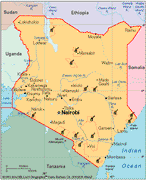
IN KENYA - EPISODE C
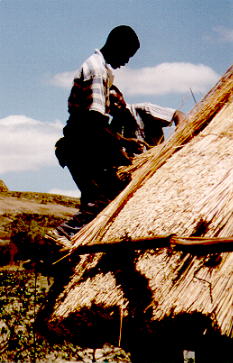
Over one
billion people - a fifth
of the world's population
- are homeless or live in
very poor housing. The
number is rising rapidly:
the United Nations
believes it may reach two
billion early in the next
century. Adequate shelter
is, therefore, one of the
most urgent needs in
world development.
During the
past few years,
traditional roofing
materials have
increasingly lost their
importance: grass and
thatch roofs have a short
lifespan and the raw
material is getting
scarce; burnt clay tiles
require much energy input
in production and a heavy
timber substructure for
the house. The existing
industrial alternatives
as for example asbestos
cement or galvanized iron
are the most widespread
of non-traditional
roofing products but they
require a high initial
investment.
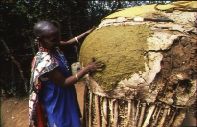
A Massai woman builder
plastering her
traditional Massai house
in Kenya
(Shelter Forum - click on
the picture)
One of the most effective
ways of overcoming these
problems is to use
building materials and
construction techniques
that poor people can
afford and manage
themselves, drawing upon
local resources and
skills. This has the
added benefit of creating
employment among local
manufacturers and
builders.
New
shelter policies are also
needed - for instance, in
helping poor people to
obtain loans to buy land
and build houses, in
providing security of
tenure, or in devising
building codes that allow
the use of alternative
materials in
construction.
Non-government
organizations (NGOs) and
community groups can play
an important role in
addressing such issues
and stimulating change,
especially with the
state's retreat from this
sector in many countries.

Massai women in Kajido
putting the finishing
touches to a new roof
Marisiet Saitoti is a
member of one of the
Massai women's groups
that IT has been working
with in Kajiado District
in Kenya. Her home, which
was in need of repair, is
now a demonstration house
for new building
techniques developed at
the Massai Rural Training
Centre with IT's help.

Marisiet's priorities
were to reduce the amount
of time she was spending
on keeping the roof
waterproof and on
collecting water, to cut
down the amount of smoke
from her cooking fire
lingering in the house
and to increase the light
coming in. She agreed
with her group who would
work on the necessary
improvements and which
materials she would
provide herself. Her
house now has a
ferro-cement roof with
built-in gutters to
collect rainwater and a
ferro-cement water jar
for keeping it. Improved
windows and ventilation
let in light and allow
smoke to escape.
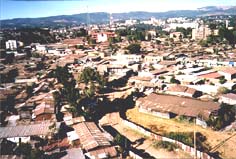
Click on the picture to
access:
"Alternative
Roofing Material - A
Study in Ethiopia"
In Ethiopia, as in many
other developing
countries, there is a
scarcity of roofing
materials. In Addis
Ababa, the focus of this
study, 95% of the roofs
are covered with
galvanized corrugated
iron sheets (CIS). The
aim of the study was to
investigate what types of
roofing materials could
be produced in Ethiopia
as alternative to CIS.
The new materials should
be possible to produce
using locally available
raw materials, and the
need of import should be
minimized. Three
alternative roofing
materials were proposed:
1.
Concrete roofing tiles.
This material is widely
used all over the world
including many African
countries. Roofs of
concrete roofing tiles
are known to have good
durability. The material
can be produced in small
scale using simple but
sturdy equipment.
2.
Fibre and micro concrete
roofing (FCR/MCR) A
limited production of FCR
tiles exist today.
FCR/MCR are, however,
relatively new materials
on the market and their
durability is not well
documented.
3. Clay
tiles. This material was
produced previously in
Ethiopia. The material
has good durability and
high aesthetic qualities.
The main disadvantage is
the high energy
consumption in
production.

Fibre Concret Roofing
(FCR) Technology seems to
be a viable alternative.
FCR can be produced,
either as sheets or
tiles, in small
decentralized plants. It
requires little initial
investment and little
energy input in
production. Generally the
raw materials, cement,
sand, fibres like sisal
or coir, plastic sheets
and water are available
locally. Local
availability of raw
materials for FCR
production also means
foreign exchange savings
on the import of
asbestos-cement and
corrugated iron sheets.
But even if there is no
local cement plant in a
country, there is a
foreign exchange saving
since most of the product
value is added locally.
FCR production is very
labour intensive; job
creation is possible with
little investment...
...Radio
Bridge Overseas is going
to tell you a
success-story from Kenya.
GEORGE
MSUMBA OF RBO
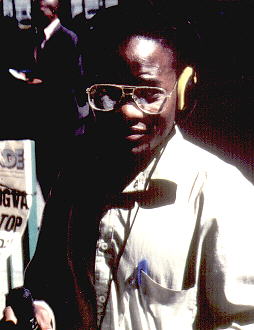
REPORTING FROM KENYA
"How to make a
strong roof from fibre
and concrete"
14'59" / LISTEN

You can go
back to the introduction
page by hitting the
button above,
or you access episodes of
your choice by clicking
on one of the thumbnails
below.


|